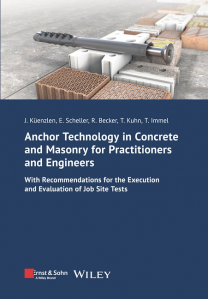Table of contents
1 Introduction
1.1 General
1.2 By way of an introduction: a real conversation about anchors in a private situation
1.3 Anchor technology for professionals
2 European regulations
2.1 General
2.2 European Technical Assessment (ETA)
2.3 CE marking
2.4 The most important regultions referred to in this book
3 Base material - In what material do I want to fasten my anchors?
3.1 General
3.2 Identifying the base material on the construction site
3.2.1 Identifying the base material by means of construction documents
3.2.2 Identifying the base material without construction documents
4 Base materials in detail
4.1 Concrete
4.1.1 General
4.1.2 Cracked (reinforced) concrete
4.1.3 Uncracked concrete
4.1.4 Types of concrete
4.1.5 Compressive strength classes
4.2 Masonry
4.2.1 General
4.2.2 Solid and vertically perforated clay bricks
4.2.3 Solid and perforated calcium silicate units
4.2.4 Solid and hollow lightweight concrete blocks
4.2.5 Aerated concrete blocks
4.2.6 Autoclaved aerated concrete: wall, floor and roof panels
4.2.7 Solid and hollow masonry units made from normal-weight concrete
4.2.8 Natural stone
4.2.9 Base materials subsequently insulated
5 Environment - Which external influences affect my fastenings?
5.1 General
5.2 Temperature
5.3 Freezing Temperatures
5.4 Fire
5.5 Corrosion
5.5.1 Advice in the approvals for anchors
5.5.2 Advice for anchoring fastenings in concrete according to EN 1992-4
5.5.3 Additional helpful information
6 Member dimensions - Where can I install my anchor?
6.1 Definitions of important terms and dimensions in anchor technology
6.2 (Minimum) member thickness
6.2.1 Concrete
6.2.2 Masonry
6.3 Edge distance c
6.3.1 Concrete
6.3.2 Masonry
6.4 Spacing s
6.4.1 Concrete
6.4.2 Masonry
6.5 Regulations for approved plastic anchors
7 Fixtures and anchor plates - What do I want to fasten?
7.1 General
7.2 The theory behind fixtures and anchor plates
7.3 The support of the fixture
7.3.1 General
7.3.2 Fixture with statically determinate supports - single fastening
7.3.3 Fixture with statically indeterminate supports - multiple fastenings
7.3.4 Summary with one example
7.4 Clearance holes in fixtures
7.5 Types of installation
7.5.1 General
7.5.2 Pre-positioned installation
7.5.3 In-place installation
7.6 Hole patterns in fixtures (arrangement of fastenings)
7.7 Fixtures and anchor plates in practice
8 Actions - Which loads act on my fastening?
8.1 General
8.2 Loading directions (nature of the loading)
8.3 Action effects (types of load)
8.4 Design is the job of the planning team!
8.5 An example to illustrate action effects
8.5.1 General
8.5.2 Structural system
8.5.3 Self-weight - dead load
8.5.4 Imposed loads
8.5.5 Actions on the anchors due to dead and imposed loads
8.5.6 Dynamic loads
8.5.7 Summary
9 Anchor systems
9.1 Introduction
9.2 Anchor systems for anchorages in concrete
9.2.1 Metal anchors
9.2.2 Bonded anchors
9.3 Anchor systems for anchorages in concrete and masonry - plastic anchors
9.4 Anchor systems for anchorages in masonry - injection systems
10 Design
11 Installation
11.1 Installation technicians - qualified personnel
11.2 Drill bits - drilling - cleaning out drilled holes
11.2.1 General
11.2.2 Position of the hole
11.2.3 Drilling methods
11.2.4 Cleaning the drilled hole
11.2.5 Aborted holes
11.3 Temperature - processing time - curing time
12 Typical mistakes and what we can do differently or better
12.1 General
12.2 Environment - corrosion
12.3 Member dimensions - edge distances and spacings
12.4 Anchor systems
12.5 Installation of anchors
13 Summary - How do I solve my fastening task?
14 Determining the resistances of plastic anchors and metal injection anchors by means of job site tests
14.1 Introduction
14.2 Principles for job site tests involving masonry base materials
14.3 Responsibilities
14.4 Technical Rule 'Execution and evaluation of job site tests of plastic anchors for use in concrete and masonry with ETA'
14.5 Practical example 1: Tension tests on plastic anchors (tests to failure) - fastening of a façade support structure
14.6 Technical Rule 'Execution and evaluation of job site tests of injection anchor systems for use in masonry with ETA'
14.7 Practical example 2: Tension tests for injection anchors (tests to failure) - fastening a balustrade for a French balcony
14.8 Summary
Appendix 1 Execution and evaluation of job site tests of plastic anchors for use in concrete and masonry with ETA in accordance with EAD 330284-00-0604 or ETAG 020
Appendix 2 Execution and evaluation of job site tests of injection anchor systems for use in masonry with ETA in accordance with EAD 330076-00-0604 or ETAG 029

